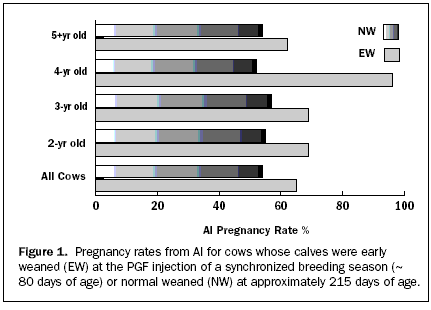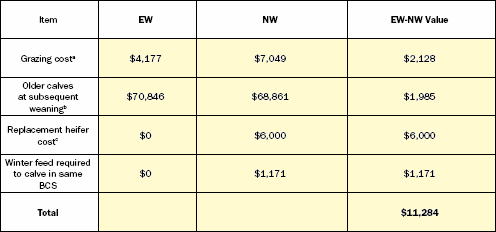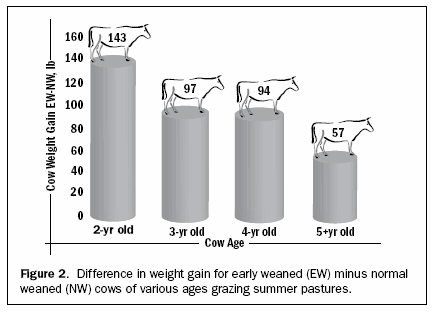



Early Weaning: An Alternative Management Strategy
By Richard Waterman (Range nutritionist), USDA-ARS, Livestock and Range Research Laboratory.Collaborators: Tom Geary, USDA-ARS - John Paterson, Department of Animal and Range Sciences, Montana State University - Ray Ansotegui, and Jerry Lipsey, American Simmental Association. Published by Montana State University from Beef Q & A.
Why consider early weaning?

Economic and herd sustainability may be optimized by early weaning calves during times when forage quantity and/or quality are insufficient to meet cow requirements (e.g., drought) or when there is concern about cow body condition going into winter and reproductive success for the subsequent year (especially, young 2 and 3-yr old cows). Consequences of extended drought often lead to extensive liquidation of cowherds, which may result in loss of genetic diversity and recent herd advancements. Early weaning can ease the pressure to liquidate, simply by reducing the nutritional demands of lactation, thereby reducing forage consumption and optimizing the opportunity for a cow to rebreed. Suckling delays the onset of estrus in beef cows (Short et al., 1972), and early weaning before the breeding season has been reported to shorten the postpartum anestrous period and increase conception rates (Bellows et al., 1974; Lusby et al., 1981).
Synchronization of estrus using protocols that include an intravaginal progesterone insert (CIDR) induced estrous cycles in postpartum anestrous beef cows (Lamb et al., 2001; Perry et al., 2004). Pregnancy rates were similar for estrous cycling and anestrous cows synchronized with gonadotropin releasing hormone (GnRH) injection at CIDR insertion, prostaglandin (PGF) at CIDR removal and fixed time insemination with a second injection of GnRH (Lamb et al., 2001). Use of 48 hour temporary calf removal from the time of PGF to GnRH + fixed time AI among cows receiving GnRH 7 days before PGF increased AI pregnancy rates among both cyclic and anestrous cows (Geary et al., 2001).
However, early weaning will raise initial cash cost for production and reliance on harvested or purchased feeds, labor, and management. Calves weaned at 70 to 150 days of age often exhibit improved ADG and are subsequently heavier at time of traditional weaning or 205 days of age (Neville and McCormick, 1981; Myers et al., 1999b; Story et al., 2000). In addition, early weaned steer calves have been shown to grade higher than traditionally weaned calves on similar diets (Myers et al., 1999a). Therefore, livestock producers may be able to recover the initial cash cost due to early weaning, and possibly receive a premium for their calves.
The objectives of this initial study conducted were to evaluate performance and cost of production of early weaned calves (~ 80 days of age) fed one of two diets (Diets were isonitrogenous and isocaloric but differed in ruminal degradable and undegradable protein) compared to normal weaned calves (~ 215 days of age). In addition, another objective of this study was to determine effects of early and permanent weaning at the start of breeding on cow reproductive performance following AI with a 50 day cleanup breeding season among cows in the Northern Great Plains.
Outcomes from current study!
Calving date (48.5 ± 1.14 days (mid February)), birth weight (84.4 ± 2.09 lb), pre-test weights (237.2 ± 4.85 lb), and age at early (78.5 ± 0.22 days) and normal (211.8 ± 0.28 days) weaning for steer and heifer calves did not differ between treatments. Weights obtained on day 85 of the study revealed lighter weights for NW vs. EW steers (502.65, 533.30, and 528.89 lb for NW, EW1, and EW2, respectively), but no differences between EW steer treatments. However, heifer weights remained similar after 85 days for NW and EW treatments.Weaning weight at 113 days from inception of early weaning treatments until time of normal weaning revealed that calves in the NW treatment weighed less than those early weaned, however, no differences in weaning weight were observed between EW treatments. This agrees with previous studies that showed early weaning allowed for heavier calves at time of normal weaning or around 205 d of age (Lusby et al., 1981; Neville and McCormick, 1981; Fluharty et al., 2000).
As expected, early weaning increases the initial cost of producing beef steers and heifers and intensifies management obligations to construct facilities or make accommodations to manage young calves. The average overall value of steers at time of normal weaning was lower for NW than EW ($785.51, $817.32, and $823.24 for NW, EW1 and EW2, respectively). This observation held true for heifers as well with NW heifers valued less than EW heifer ($686.75, $711.96, and $717.06 for NW, EW1 and EW2, respectively). However, the extra value from early weaned calves was not sufficient to overcome the initial cost for the early weaning diets, therefore the additional expenses need to be recovered from other facets of production.
Pregnancy rates from AI were higher for early weaned cows (66%) compared to normal weaned cows (54%; Figure 1). Laster et al. (1973) reported increased conception rates following AI during a 42-day breeding season among young (2 and 3-yr-old) cows. Temporary calf removal for 48 hours beginning at PGF injection of similar estrous synchronization protocols improved AI pregnancy rates (Smith et al., 1979; Kiser et al., 1980; Geary et al., 2001), but the magnitude of improvement was less than observed in the current study, indicating that perhaps permanentcalf removal also improved maintenance of pregnancy. Similar improvements in AI pregnancy rate for EW cows were realized across each age group (Figure 1)
Estimated date of conception was also 7 days earlier for early weaned cows compared to normal weaned cows. Assuming that early weaned cows calve an average of 7 days earlier and that these calves would gain 2.6 lb/d, this difference in calf age at weaning would be worth approximately $1,985 per 100 calves from early weaned cows (Table 1).

Pregnancy rates from the entire 50-d breeding season were slightly greater for cows that were early weaned (94%) compared to normal weaned (89%). A similar tendency for improvement in breeding season pregnancy rate has been observed previously (Myers et al., 1999a). Among primiparous cows, Lusby et al. (1981) reported 38% higher pregnancy rates. It is possible that the synchronization protocol used in cows in the present study masked some of the beneficial effects because these protocols have been reported to induce estrous cycles (Lamb et al., 2001; Lucy et al., 2001; Larson et al., 2006). Maintaining herd size would require purchase of five pregnant replacement heifers for the normalweaned herd on a per 100 cow basis. Replacement heifers of similar genetics last year in Montana were valued at approximately $1,200 (Table 1).
Initial weight of cows did not differ between treatments. Early weaned cows gained more weight during the grazing period and were 79 lb heavier than normal weaned cows at the time of normal weaning. The difference in weight gain between early and normal weaned cows was greatest among 2-yr-olds and decreased with increased age (Figure 2). Similar improvements in weight gain for early weaned compared to normal weaned primiparous cows grazing summer pastures have been reported previously (Lusby et al., 1981). Myers et al. (1999a) reported improved weight gain for early weaned cows compared to normal weaned cows even when calves were weaned at 158 to 177 days compared to 213 to 231 days of age. Early weaned cows would be expected to have consumed 1/3 animal unit month (AUM) less forage than normal weaned cows during the grazing period. Grazing leases averaged $15.90 per AUM in the area where this study was conducted. Thus, during the 133 days (4.43 months) interval from early weaning to normal weaning, grazing costs were $4,933 greater for normal weaned cows compared to early weaned cows. This difference in cost is equivalent to $2,128 per 100 cows (Table 1).
Others have reported that 75 lb of weight difference in cattle of similar genetics is equivalent to one body condition score (Corah et al., 1991). Thus, early weaned cows were approximately 1.0 BCS greater at the time of normal weaning.

b Estimated additional weaning weight in subsequent year due to 7 days earlier conception date. Calf gain estimated at 2.71lb/d of age and price estimated at $1.05/lb.
c Purchase of five additional pregnant replacement heifers valued at $1,200/hd.
Feeding early and normal weaned cows to the same BCS at calving suggests early weaned cows should require approximately 335 lb less feed (ex. barley hay with 0.58 Mcal/ lb, DM basis, @ $70/T) during the winter to be maintained sufficiently to calve in the same BCS as normal weaned cows. Alternatively, normal weaned cows, being 1.0 BCS lower going into winter, would need 335 lb additional feed (ex. barley hay) to be at the same BCS at calving as early weaned cows. Estimated cost difference of winter supplemental feed for early and normal weaned cows is $11.71 per cow (Table 1).
What does this means?

Early weaning beef calves at or before breeding will increase initial cash costs and management responsibilities for production. In addition, the increased value of early weaned calves alone at time of normal weaning may not offset the cost of early weaning diets as observed in the present study. The value of early weaning may however, be derived from improved feedlot gain and carcass improvements, increased conception rates for not only the year early weaning occurred, but for the subsequent year as well. Early weaning may prove to be a valuable alternative to traditional management practices in the Northern Great Plains once all facets of production have been fully assessed, especially during times of reduced forage production.
We conclude early weaning at the start of a synchronized breeding season increased AI pregnancy rates, tended to increase breeding season pregnancy rates, and increased cow weight at the time of normal weaning. Similar improvements in pregnancy rates were observed across all age groups. The magnitude of improvement in AI pregnancy rate is greater than has been reported with temporary calf removal (48 hours) indicating permanent calf removal may improve pregnancy maintenance. The greatest increase in weight gain was among 2-yr old cows. Early weaning may be a viable alternative to culling cows and/or maintaining high levels of reproductive performance among young cows during periods of low forage production in the Northern Great Plains.


